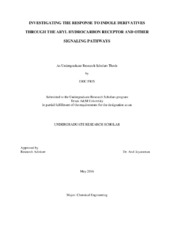| dc.description.abstract | Gastrointestinal tract bacteria can transform molecules into metabolites that can either be utilized
by the mammalian host or can induce signaling in the host. One such metabolite, indole (and its
derivatives), is generated from the amino acid tryptophan. Indole is small and can passively
diffuse into the host cell. Indole and its derivatives such as indole-3-acetate (I3A) have been
shown to activate the the aryl hydrocarbon receptor (Ahr), which, in turn, activates a range of
signaling pathways. However, preliminary data from our lab suggest that indole derivatives also
bind to extracellular cell surface receptors. This work proposes to investigate the balance
between Ahr-mediated signaling and Ahr-independent signaling by indole derivatives. This
project also seeks to develop a mathematical model to describe this mechanism, as well as test
the general applicability of this response in different cell lines. | en |


